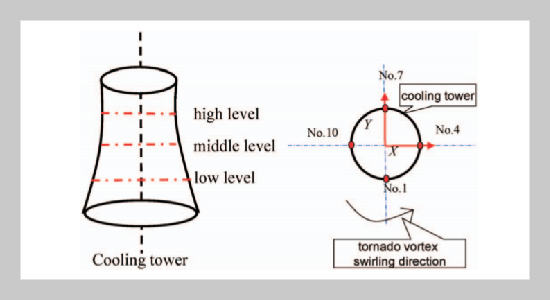REFERENCES
- [1] Golden, J. H. and Snow, J. T., “Mitigation Against Extreme Windstorms,” Reviews of Geophysics, Vol. 29, No. 4, pp. 477�504 (1991). doi: 10.1029/91RG01814
- [2] Church, C., Snow, J. T., Baker, G. L. and Agee, E. M., “Characteristics of Tornado-like Vortices as aFunction of Swirl Ratio: a Laboratory Investigation,” Journal of the Atmospheric Sciences, Vol. 36, pp. 1755�1776 (1979). doi: 10.1175/1520-0469(1979)036<1755: CO TLVA>2.0.CO;2
- [3] Ward, N. B., “The Exploration of Certain Features of Tornado Dynamics Using a Laboratory Model,” Journal of the Atmospheric Sciences, Vol. 29, pp. 1194� 1204 (1972). doi:10.1175/15200469(1972)029<1194: TEOCFO>2.0.CO;2
- [4] Haan, F. L., Sarkar, P. P. and Gallus, W. A., “Design, Construction and Performance of a Large Tornado Simulator for Wind Engineering Applications,” Engineering Structures, Vol. 30, No. 4, pp. 1146�1159 (2008). doi: 10.1016/j.engstruct.2007.07.010
- [5] Jischke, M. C. and Light, B. D., “Laboratory Simulation of Tornadic Wind Loads on a Rectangular Model Structure,” Journal of Wind Engineering and Industrial Aerodynamics, Vol. 13, pp. 371�382 (1983). doi: 10.1016/0167-6105(83)90157-5
- [6] Bienkiewicz, B. and Dudhia, P., “Physical Modeling of Tornado-like Flow and Tornado Effects on Building Loading,” Proceedings of the Seventh US National Conference on Wind Engineering, pp. 95�106 (1993).
- [7] Mishra, A. R., James, D. J. and Letchford, C. W., “Physical Simulation of a Single-celled Tornado-like Vortex, Part B. Wind Loading on a Cubical Model,” Journal of Wind Engineering and Industrial Aerodynamics, Vol. 96, pp. 1258�1273 (2008). doi: 10.1016/ j.jweia.2008.02.027
- [8] Rajasekharan, S. G., Matsui, M. and Tamura, Y., “Characteristics of Internal Pressures and Net Local Roof Wind Forces on a Building Exposed to a Tornado-like Vortex,” Journal of Wind Engineering and Industrial Aerodynamics, Vol. 112, pp. 52�57 (2013). doi: 10. 1016/j.jweia.2012.11.005
- [9] Sarkar, P. P., Haan, F. L., Balaramudu, V. and Sengupta, A., “Laboratory Simulation of Tornado and Microburst to Assess Wind Loads on Buildings,” Structures Congress, St. Louis, MO (2006). doi: 10.1061/40889 (201)11
- [10] Sengupta, A., Haan, F. L., Sarkar, P. P. and Balaramudu, V., “Transient Loads on Buildings in Microburst and Tornado Winds,” Journal of Wind Engineering and Industrial Aerodynamics, Vol. 96, pp. 2173�2187 (2008). doi: 10.1016/j.jweia.2008.02.050
- [11] Haan Jr, F. L., Balaramudu, V. K. and Sarkar, P. P., “Tornado-induced Wind Loads on a Low-rise Building,” Journal of Structural Engineering, Vol. 136, No. 1, pp. 106�116 (2010). doi: 10.1061/(ASCE)ST.1943541X.0000093
- [12] Cao, S., Wang, J., Cao, J., Zhao, L. and Chen, X., “Experimental Study of Wind Pressures Acting on a Cooling TowerExposedtoStationaryTornado-likeVortices,” Journal of Wind Engineering and Industrial Aerodynamics, Vol. 145, pp. 75�86 (2015). doi: 10.1016/j. jweia.2015.06.004
- [13] Mitsuta, Y. and Monji, N., “Development of a Laboratory Simulator for Small Scale Atmospheric Vortices,” Natural Disaster Science, Vol. 6, pp. 43�53 (1984).
- [14] Matsui, M. and Tamura, Y., “Influence of Incident Flow Conditions on Generation of Tornado-like Flow,” Proceedings of the 11th American Conference on Wind Engineering, Puerto Rico, USA(2009).
- [15] Refan, M., Hangan, H. and Wurman J., “Reproducing Tornadoes in Laboratory Using Proper Scaling,” Journal of Wind Engineering and Industrial Aerodynamics, Vol. 135, pp. 136�148 (2014). doi: 10.1016/j. jweia.2014.10.008
- [16] Wang, J., Cao, S. Y., Pang, W. Q., Cao, J. X. and Zhao, L., “The Effects of Ground Roughness on the Characteristics of Tornado-like Vortices,” Proceedings of 14th International Conference on Wind Engineering, Brazil (2015).
















